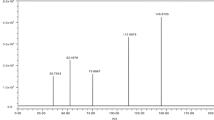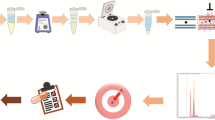Abstract
Ceritinib is a highly selective inhibitor of an important cancer target, anaplastic lymphoma kinase (ALK). Because it is an investigational compound, there is a need to develop a robust and reliable analytical method for its quantitative determination in human plasma. Here, we report the validation of a liquid chromatography tandem mass spectrometry (LC-MS/MS) method for the rapid quantification of ceritinib in human plasma. The method consists of protein precipitation with acetonitrile, and salting-out assisted liquid-liquid extraction (SALLE) using a saturated solution of sodium chloride prior to analysis by LC-MS/MS with electrospray ionization (ESI) technique in positive mode. Samples were eluted at 0.800 mL min−1 on Ascentis Express® C18 column (50 mm × 2.1 mm, 2.7 μm) with a mobile phase made of 0.1 % formic acid in water (A) and 0.1 % formic acid in acetonitrile (B). The method run time was 3.6 min and the low limit of quantification (LLOQ) was estimated at 1.00 ng mL−1 when using 0.100 mL of human plasma. The assay was fully validated and the method exhibited sufficient specificity, accuracy, precision, and sensitivity. In addition, recovery data and matrix factor (MF) in normal and in hemolyzed plasmas were assessed, while incurred samples stability (ISS) for ceritinib was demonstrated for at least 21 months at a storage temperature of −65 °C or below. The method was successfully applied to the measurement of ceritinib in clinical samples and the data obtained on incurred samples reanalysis (ISR) showed that our method was reliable and suitable to support the analysis of samples from the clinical studies.



Similar content being viewed by others
References
Jemal A, Siegel R, Ward E, Hao Y, Xu J, Murray T, Thun MJ (2008) Cancer statistics, 2008. CA Cancer J Clin 58(2):71–96. doi:10.3322/ca.2007.0010
Koivunen JP, Mermel C, Zejnullahu K, Murphy C, Lifshits E, Holmes AJ, Choi HG, Kim J, Chiang D, Thomas R, Lee J, Richards WG, Sugarbaker DJ, Ducko C, Lindeman N, Marcoux JP, Engelman JA, Gray NS, Lee C, Meyerson M, Janne PA (2008) EML4-ALK fusion gene and efficacy of an ALK kinase inhibitor in lung cancer. Clin Cancer Res Off J Am Assoc Cancer Res 14(13):4275–4283. doi:10.1158/1078-0432.CCR-08-0168
Martelli MP, Sozzi G, Hernandez L, Pettirossi V, Navarro A, Conte D, Gasparini P, Perrone F, Modena P, Pastorino U, Carbone A, Fabbri A, Sidoni A, Nakamura S, Gambacorta M, Fernandez PL, Ramirez J, Chan JK, Grigioni WF, Campo E, Pileri SA, Falini B (2009) EML4-ALK rearrangement in non-small cell lung cancer and non-tumor lung tissues. Am J Pathol 174(2):661–670. doi:10.2353/ajpath.2009.080755
Shaw AT, Solomon B (2011) Targeting anaplastic lymphoma kinase in lung cancer. Clin Cancer Res Off J Am Assoc Cancer Res 17(8):2081–2086. doi:10.1158/1078-0432.CCR-10-1591
Marsilje TH, Pei W, Chen B, Lu W, Uno T, Jin Y, Jiang T, Kim S, Li N, Warmuth M, Sarkisova Y, Sun F, Steffy A, Pferdekamper AC, Li AG, Joseph SB, Kim Y, Liu B, Tuntland T, Cui X, Gray NS, Steensma R, Wan Y, Jiang J, Chopiuk G, Li J, Gordon WP, Richmond W, Johnson K, Chang J, Groessl T, He YQ, Phimister A, Aycinena A, Lee CC, Bursulaya B, Karanewsky DS, Seidel HM, Harris JL, Michellys PY (2013) Synthesis, structure-activity relationships, and in vivo efficacy of the novel potent and selective anaplastic lymphoma kinase (ALK) inhibitor 5-chloro-N2-(2-isopropoxy-5-methyl-4-(piperidin-4-yl)phenyl)-N4-(2-(isopropylsulf onyl)phenyl)pyrimidine-2,4-diamine (LDK378) currently in phase 1 and phase 2 clinical trials. J Med Chem 56(14):5675–5690. doi:10.1021/jm400402q
Shaw AT, Kim DW, Mehra R, Tan DS, Felip E, Chow LQ, Camidge DR, Vansteenkiste J, Sharma S, De Pas T, Riely GJ, Solomon BJ, Wolf J, Thomas M, Schuler M, Liu G, Santoro A, Lau YY, Goldwasser M, Boral AL, Engelman JA (2014) Ceritinib in ALK-rearranged non-small-cell lung cancer. N Engl J Med 370(13):1189–1197. doi:10.1056/NEJMoa1311107
Guidance for Industry: Bioanalytical Method ValidationUS Department of Health and Human Services FaDA, Center for Drug Evaluation and Research, Rockville, MD (2001) Available from: http://www.fda.gov/CVM (2001)
European Medicines Agency (2012) Guideline on bioanalytical method validation
Author information
Authors and Affiliations
Corresponding author
Electronic supplementary material
Below is the link to the electronic supplementary material.
ESM 1
(PDF 54.7 kb)
Rights and permissions
About this article
Cite this article
Heudi, O., Vogel, D., Lau, Y.Y. et al. Liquid chromatography tandem mass spectrometry method for the quantitative analysis of ceritinib in human plasma and its application to pharmacokinetic studies. Anal Bioanal Chem 406, 7389–7396 (2014). https://doi.org/10.1007/s00216-014-8125-9
Received:
Accepted:
Published:
Issue Date:
DOI: https://doi.org/10.1007/s00216-014-8125-9




